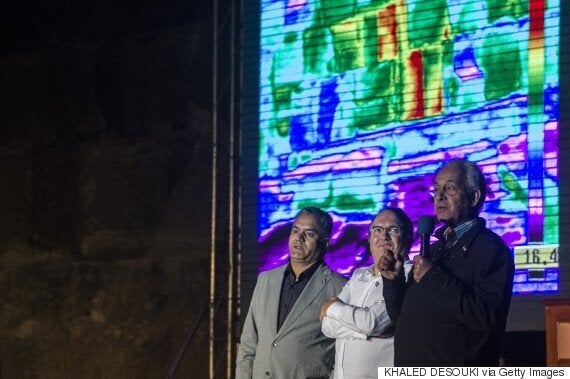Ancient hidden chambers and passages not explored for thousands of years could lie behind strange heat spots discovered during a scan of the Great Pyramid at Giza.
The Egyptian Ministry of Antiquities has revealed that an international team of archeologists, architects and scientists have observed the phenomena deep within the structure's core buried within its stones.
Despite the natural tendency of stone to be cooler than other materials, significantly higher temperatures were observed in three connected blocks at the base of the pyramid.

Egyptian Minister of Antiquities and two scientists from the international team speak in front of the pyramid at Giza
Dating as far back as 2580 BC, the group of monuments at Giza were the final resting places of pharaohs Khufu, also known as Kheops, Khafre, known as Khephren, and Menkaure, as Mycerinus.

The three stones with significantly higher temperature lie at the base of the main pyramid at Giza
Antiquities Minister Mamdouh el-Damaty and technical experts working on the project showed the results of their research to an assembled audience of international media at the base of the Great Pyramid on Monday.
"The first row of the pyramid's stones are all uniform, then we come here and find that there's a difference in the formation," said el-Damaty, pointing at the three stones showing higher temperatures.
Explaining the find, el-Damaty said "that there is something like a small passage in the ground that you can see, leading up to the pyramids ground, reaching an area with a different temperature. What will be behind it?"
Scanning showed "a particularly impressive one (anomaly) located on the Eastern side of the Khufu pyramid at ground level," the ministry said in a statement.
Aside from previously unexplored chambers and passages, other potential explanations include internal air currents and the differing density of building materials.
But the discoveries may continue. The Operation Scan Pyramids project, which began just two weeks ago, is expected to last until later in 2016.